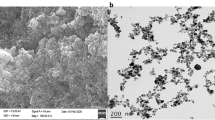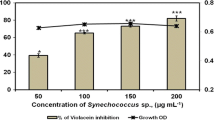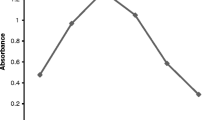Abstract
Aquaculture production is affected by disease outbreak, which affects the production, profitability, and sustainability of the global aquaculture industry. Antibiotics have been widely used to control various infectious diseases. Indiscriminate usage of antibiotics results in development of antibiotic resistance in pathogens. This current study aims to synthesize myrobalan-mediated green silver nanocolloids (MBNc) by using the extract of three myrobalans and characterized by using various physiochemical techniques. Antibacterial potential of MBNc was screened in vibriosis causing pathogens (V. harveyi, V. alginolyticus, V. Parahaemolyticus), and foodborne pathogen S. haemolyticus, isolated from infected fish. Further, the presence of ESBL genes including CTX-M-15 and Amp C was analyzed in control and MBNc-treated strains. From our studies, it was observed that MBNc was very effective in controlling the growth. MBNc confirmed the anti-biofilm property in all tested marine pathogens and effectively abolish the genes encoding CTX-M-15 in tested pathogens. Thus, MBNc can be formulated to control the growth of marine pathogens and it can be used as an alternative to antibiotics to prevent infection in cage culturing and aquafarming.





Similar content being viewed by others
Availability of Data and Material
Data will be available on request.
Code Availability
Not applicable.
References
Hosomi, R., Yoshida, M., & Fukunaga, K. (2012). Seafood consumption and components for health. Global Journal of Health Science. https://doi.org/10.5539/gjhs.v4n3p72
Tidwell, J. H. & Allan, G. L. (2001). Fish as food: aquaculture's contribution. Ecological and economic impacts and contributions of fish farming and capture fisheries. EMBO Rep, 2(11), 958–963. https://doi.org/10.1093/embo-reports/kve236
Lafferty, K., Harvell, C., Conrad, J., et al. (2015). Infectious diseases affect marine fisheries and aquaculture economics. Annual Review of Marine Science, 7, 471–496. https://doi.org/10.1146/annurev-marine-010814-015646
Newton, A., Kendall, M., Vugia, D., et al. (2012). Increasing rates of vibriosis in the United States, 1996–2010: Review of surveillance data from 2 systems. Clinical Infectious Diseases, 54, S391–S395. https://doi.org/10.1093/cid/cis243
Osunla, C., & Okoh, A. (2017). Vibrio pathogens: A public health concern in rural water resources in Sub-Saharan Africa. International Journal of Environmental Research and Public Health, 14, 1188. https://doi.org/10.3390/ijerph14101188
Austin, B., & Zhang, X. (2006). Vibrio harveyi: A significant pathogen of marine vertebrates and invertebrates. Letters in Applied Microbiology, 43, 119–124. https://doi.org/10.1111/j.1472-765x.2006.01989.x
Liu, C., Cheng, W., Hsu, J., & Chen, J. (2004). Vibrio alginolyticus infection in the white shrimp Litopenaeus vannamei confirmed by polymerase chain reaction and 16S rDNA sequencing. Diseases of Aquatic Organisms, 61, 169–174. https://doi.org/10.3354/dao061169
Lee, D., Moon, S., Lee, S., et al. (2008). Septic shock due to Vibrio alginolyticus in a cirrhotic patient: The first case in Korea. Yonsei Medical Journal, 49, 329. https://doi.org/10.3349/ymj.2008.49.2.329
Parthasarathy, S., Das, S., & Kumar, A. (2016). Occurrence of pathogenic Vibrio parahaemolyticus in crustacean shellfishes in coastal parts of Eastern India. Veterinary World, 9, 330–336. https://doi.org/10.14202/vetworld.2016.330-336
Czekaj, T., Ciszewski, M., & Szewczyk, E. (2015). Staphylococcus haemolyticus – An emerging threat in the twilight of the antibiotics age. Microbiology, 161, 2061–2068. https://doi.org/10.1099/mic.0.000178
Prestinaci, F., Pezzotti, P., & Pantosti, A. (2015). Antimicrobial resistance: A global multifaceted phenomenon. Pathogens and Global Health, 109, 309–318. https://doi.org/10.1179/2047773215y.0000000030
Barros, C., Fulaz, S., Stanisic, D., & Tasic, L. (2018). Biogenic nanosilver against multidrug-resistant bacteria (MDRB). Antibiotics, 7, 69. https://doi.org/10.3390/antibiotics7030069
Ranjani, S., Pradeep, P., Vimalkumar, U., Ramesh Kumar, V., & Hemalatha, S. (2021). Pungent antiinfective nanocolloids manipulate growth, biofilm formation and CTX-M-15 gene expression in pathogens causing vibriosis. Aquaculture International, 29, 859–869.
Hemamalini, V., Kavitha, V., & Ramachandran, S. (2015). In vitro antibiogram pattern of Staphylococcus aureus isolated from wound infection and molecular analysis of mecA gene and restriction sites in methicillin resistant Staphylococcus aureus. Journal of Advanced Pharmaceutical Technology and Research, 6, 170. https://doi.org/10.4103/2231-4040.165019
Ranjani, S., Shariq Ahmed, M., Ruckmani, K., & Hemalatha, S. (2019). Green nanocolloids control multi drug resistant pathogenic bacteria. Journal of Cluster Science, 31, 861–866. https://doi.org/10.1007/s10876-019-01694-6
Ranjani, S., Tamanna, K., & Hemalatha, S. (2020). Triphala green nano colloids: Synthesis, characterization and screening biomarkers. Applied Nanoscience, 10, 1269–1279. https://doi.org/10.1007/s13204-019-01208-w
Ranjani, S., Faridha Begum, I., Tasneem, I. K., Senthil Kumar, N., & Hemalatha, S. (2020). S. Silver decorated green nanocolloids as potent antibacterial and antibiofilm agent against antibiotic resistant organisms isolated from tannery effluent. Inorganic and Nano-Metal Chemistry. https://doi.org/10.1080/24701556.2020.1811326
Ranjani, S. A., Matheen, A., Jenish, A., & Hemalatha, S. (2021). Nanotechnology derived natural poly bio-silver nanoparticles as a potential alternate biomaterial to protect against human pathogens. Materials Letters, 130555.https://doi.org/10.1016/j.matlet.2021.130555
Harborne, J. (1980). Phytochemical methods. Springer.
Yemm, E., & Willis, A. (1954). The estimation of carbohydrates in plant extracts by anthrone. Biochemical Journal, 57, 508–514. https://doi.org/10.1042/bj0570508
Akther, T., & Hemalatha, S. (2019). Mycosilver nanoparticles: Synthesis, characterization and its efficacy against plant pathogenic fungi. BioNanoScience, 9, 296–301. https://doi.org/10.1007/s12668-019-0607-y
Akther, T., Ranjani, S., & Hemalatha, S. (2021). Nanoparticles engineered from endophytic fungi (Botryosphaeria rhodina) against ESBL-producing pathogenic multidrug-resistant E. coli. Environmental Sciences Europe, 33, 83. https://doi.org/10.1186/s12302-021-00524-9
Akther, T., Khan, M. S., & Hemalatha, S. (2020). Biosynthesis of silver nanoparticles via fungal cell filtrate and their anti-quorum sensing against Pseudomonas aeruginosa. Journal of Environmental Chemical Engineering. https://doi.org/10.1016/j.jece.2020.104365
Ranjani, S., Das, R., Shariq Ahmed, M., Lalnunmawii, E., Nachimuthu, S., Ruckmani, K., & Hemalatha, S. (2020). Myco-nanocolloids manipulate growth, biofilm formation and virulence genes in UTI causing E. coli. Inorganic and Nano-Metal Chemistry. https://doi.org/10.1080/24701556.2020.1852426
Ranjani, S., Faridha Begum, I., Santhoshini, J., Senthil Kumar, N., Ruckmani, K., & Hemalatha, S. (2020). Mimosa pudica floral nanoparticles: a potent antibiotic resistance breaker. Inorganic and Nano-Metal Chemistry. https://doi.org/10.1080/24701556.2020.1852429
Ranjani, S. M., Sheik Meeran, S., Prakash, S. P., Mohammad, W., Kandasamy, R., & Srinivasan, H. (2020). Multi potent aromatic nano colloid: Synthesis, characterization and applications. AMB Express, 10(1), 168. https://doi.org/10.1186/s13568-020-01104-5
Mittal, L., Ranjani, S., Shariq Ahmed, M., Jeya Shree, T., Akther, T., Poompavai, S., Camarillo, I. G., GowriSree, V., Sundararajan, R., & Hemalatha, S. (2020). Turmeric-silver-nanoparticles for effective treatment of breast cancer and to break CTX-M-15 mediated antibiotic resistance in Escherichia coli. Inorganic and Nano-Metal Chemistry. https://doi.org/10.1080/24701556.2020.1812644
Shariq Ahmed, M., Soundhararajan, R., Akther, T., et al. (2019). Biogenic AgNPs synthesized via endophytic bacteria and its biological applications. Environmental Science and Pollution Research, 26, 26939–26946. https://doi.org/10.1007/s11356-019-05869-6
Sah, S., Rasool, U., & Hemalatha, S. (2020). Andrographis paniculata extract inhibit growth, biofilm formation in multidrug resistant strains of Klebsiella pneumoniae. Journal of Traditional and Complementary Medicine, 10, 599–604. https://doi.org/10.1016/j.jtcme.2019.02.006
Shariq Ahmed, M. Soundhararajan, R. Akther, T. Kashif, M. Khan, J. Waseem, M. & Srinivasan, H. (2019) Biogenic AgNPs synthesized via endophytic bacteria and its biological applications. Environmental Science and Pollution Research 26, 26939–26946. https://doi.org/10.1007/s11356-019-05869-6
Rasool, U., Priya, S., Parveen, A., et al. (2018). Efficacy of Andrographis paniculata against extended spectrum β-lactamase (ESBL) producing E coli. BMC Complementary and Alternative Medicine. https://doi.org/10.1186/s12906-018-2312-8
Hasan, M., Islam, M., & Islam, M. (2016). Phytochemistry, pharmacological activities and traditional uses of Emblica officinalis: A review. International Current Pharmaceutical Journal, 5, 14–21. https://doi.org/10.3329/icpj.v5i2.26441
Tungmunnithum, D., Thongboonyou, A., Pholboon, A., & Yangsabai, A. (2018). Flavonoids and other phenolic compounds from medicinal plants for pharmaceutical and medical aspects: An overview. Medicines, 5, 93. https://doi.org/10.3390/medicines5030093
SabihaSulthana, H. B., Ranjani, S., & Hemalatha, S. (2020). Comparison of efficacy of nanoparticles synthesized from leaves and flowers of Russelia equisitiformis. Inorganic and Nano-Metal Chemistry. https://doi.org/10.1080/24701556.2020.1862218
Sai Nivetha, S., Ranjani, S., & Hemalatha, S. (2020). Synthesis and application of silver nanoparticles using Cissus quadrangularis. Inorganic and Nano-Metal Chemistry. https://doi.org/10.1080/24701556.2020.1862219
Chouhan, N. (2018). Silver nanoparticles: Synthesis, characterization and applications. Silver Nanoparticles - Fabrication, Characterization and Applications. https://doi.org/10.5772/intechopen.75611
Wang, L., Hu, C., & Shao, L. (2017). The antimicrobial activity of nanoparticles: Present situation and prospects for the future. International Journal of Nanomedicine, 12, 1227–1249. https://doi.org/10.2147/ijn.s121956
Slavin, Y., Asnis, J., Häfeli, U., & Bach, H. (2017). Metal nanoparticles: Understanding the mechanisms behind antibacterial activity. Journal of Nanobiotechnology. https://doi.org/10.1186/s12951-017-0308-z
Sanchooli, N., Saeidi, S., Barani, H. K., & Sanchooli, E. (2018). In vitro antibacterial effects of silver nanoparticles synthesized using Verbena officinalis leaf extract on Yersinia ruckeri, Vibrio cholera and Listeria monocytogenes. Iranian journal of microbiology, 10(6), 400–408.
Dakal, T., Kumar, A., Majumdar, R., & Yadav, V. (2016). Mechanistic basis of antimicrobial actions of silver nanoparticles. Frontiers in Microbiology. https://doi.org/10.3389/fmicb.2016.01831
Shah, S., Gaikwad, S., Nagar, S., et al. (2019). Biofilm inhibition and anti-quorum sensing activity of phytosynthesized silver nanoparticles against the nosocomial pathogen Pseudomonas aeruginosa. Biofouling, 35, 34–49. https://doi.org/10.1080/08927014.2018.1563686
Singh, M., Mallick, A., Banerjee, M., & Kumar, R. (2016). Loss of outer membrane integrity in Gram-negative bacteria by silver nanoparticles loaded with Camellia sinensis leaf phytochemicals: Plausible mechanism of bacterial cell disintegration. Bulletin of Materials Science, 39, 1871–1878. https://doi.org/10.1007/s12034-016-1317-5
Peterson, C., Denniston, K., & Chopra, D. (2017). Therapeutic uses of triphala in ayurvedic medicine. The Journal of Alternative and Complementary Medicine, 23, 607–614. https://doi.org/10.1089/acm.2017.0083
Charannya, S., Duraivel, D., Padminee, K., et al. (2018). Comparative evaluation of antimicrobial efficacy of silver nanoparticles and 2% chlorhexidine gluconate when used alone and in combination assessed using agar diffusion method: An In vitro study. Contemporary Clinical Dentistry, 9, 204. https://doi.org/10.4103/ccd.ccd_869_17
Acknowledgements
The authors are thankful to B.S. Abdur Rahman Institute of Science & Technology, Chennai, for providing research facilities in school of life sciences.
Funding
The authors gratefully acknowledge the Ministry of Science and Technology, Department of Science and Technology (KIRAN Division) (GoI), New Delhi. (Ref No. DST/WOS-B/2018/1583-HFN (G)) and ASEAN University network (AUN)/Southeast Asia Engineering Education Development Network (SEED)/Japan International Cooperation Agency (JICA) SPRAC (SN042/MI.KU/2020).
Author information
Authors and Affiliations
Contributions
SH conceived and designed research. SR and PP conducted experiments. PR contributed pathogenic strains. SH and PR analyzed data. All authors wrote the manuscript. All authors read and approved the manuscript.
Corresponding author
Ethics declarations
Conflict of Interest
The authors declare no competing interests.
Ethics Approval
Not applicable.
Consent to Participate
Not applicable.
Consent for Publication
All authors read and approved the manuscript for publication.
Additional information
Publisher's Note
Springer Nature remains neutral with regard to jurisdictional claims in published maps and institutional affiliations.
Rights and permissions
About this article
Cite this article
Ranjani, S., Parthasarathy, P., Rameshkumar, P. et al. Myrobalan-Mediated Nanocolloids in Controlling Marine Pathogens. Appl Biochem Biotechnol 194, 1120–1135 (2022). https://doi.org/10.1007/s12010-022-03816-9
Accepted:
Published:
Issue Date:
DOI: https://doi.org/10.1007/s12010-022-03816-9




